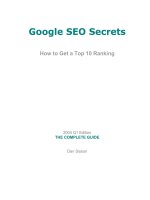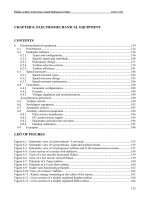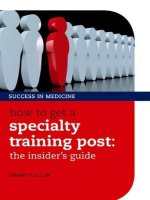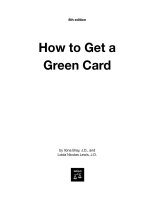google secrets how to get a top 10 ranking
Bạn đang xem bản rút gọn của tài liệu. Xem và tải ngay bản đầy đủ của tài liệu tại đây (1.3 MB, 112 trang )
Google Secrets
How to Get a Top 10 Ranking
On the Most Important Search Engine in the World
THE COMPLETE GUIDE
Dan Sisson
Google Secrets – How to Get a Top 10 Ranking… page 2 of 112
Published by Blue Moose Webworks, Inc., 16625 Redmond Way, Ste. M-215,
Redmond, WA 98052
ISBN 0-9728588-0-6 (PDF ed.)
Copyright © 2003, 2004 by Dan Sisson, Blue Moose Webworks, Inc. All rights
reserved.
No part of this publication may be reproduced or transmitted in any form or by any
means, electronic or mechanical, including photocopying, recording or by any
information storage and retrieval system, without written permission from the author,
except for the inclusion of brief quotations in a review. Published in the United States
of America.
All products and/or services mentioned in this publication bearing the name,
likeness, or image of any other company or product line are trademarks, registered
trademarks, or service marks of the respective companies identified. No
endorsement or approval by such companies is or should be inferred by their
inclusion herein. The author and Blue Moose Webworks, Inc is not affiliated with, or
endorsed by, Google Inc. in any manner.
The author has put forth a best effort in ensuring the content of this publication is
accurate and current as of the time of publication. The author is not responsible for
any inadvertent errors, omissions, or contrary interpretations of the subject matter
herein. The author makes no warranty of any kind, expressed or implied, with regard
to the information supplied. No guarantees of ranking, traffic, or income is made. The
author shall not be liable in the event of incidental or consequential damages in
connection with, or arising out of, the providing of information offered herein. The
author is not responsible for external changes that may affect the applicability of the
processes, methods, techniques, or tools discussed in this publication. The author
reserves the right to make changes to the information herein. The purchaser or
reader of this publication assumes full responsibility for the use of this information.
On the World Wide Web at
. Receive free quarterly
book updates by email with your authorized order or transaction number.
www.google-secrets.com Copyright 2003-2004 Dan Sisson.
All rights reserved.
Google Secrets – How to Get a Top 10 Ranking… page 3 of 112
Contents
Preface 6
PART I – Getting Started 8
Chapter 1 - The Importance of Google 9
Chapter 2 - How Google Works 12
So What Is a Ranking? 12
When Google Comes Visiting 14
How Google Ranks Websites 16
Chapter 3 - Determining Your Best Keywords 19
So What Exactly Are Keywords? 19
Using WordTracker 20
What is your Primary Keyword Phrase? 24
What are your Secondary Keyword Phrases? 25
Putting it All Together 26
PART II - Optimizing Your Website 27
Chapter 4 - Structuring your Site Correctly 28
Structure by Theme and Topic 28
Create Lots of Short Pages 29
Don’t Nest Your Pages 30
Don’t Bloat Your Pages With Code 31
Keywords in Your Domain Name 31
Chapter 5 - Optimizing Your Web Pages 33
Keyword Factors Used in the Algorithm 33
The Importance of the <TITLE> 34
How and Where to Use Keywords 36
Chapter 6 – Linking Your Pages Correctly 41
Structuring Your Internal Links 42
Best Practices for Internal Linking 44
Chapter 7 – More Advanced Techniques 46
Multiple Sites – Is it Worth It? 46
Domain Pointing and Subdomains 47
www.google-secrets.com Copyright 2003-2004 Dan Sisson.
All rights reserved.
Google Secrets – How to Get a Top 10 Ranking… page 4 of 112
PART III - Exchanging Links Effectively 48
Chapter 8 – The Importance of Links 49
Link Factors Used in the Algorithm 49
Introducing PageRank 50
So What is Link Quality? 50
Chapter 9 - All About PageRank 52
PageRank vs. Search Result Ranking 52
Toolbar PageRank vs. Actual PageRank 53
Increasing PageRank 54
The PageRank Equation 55
Chapter 10 - Submitting Your Site to Directories 57
About the Google Directory 57
Submitting Your Site to the OPD 58
Submitting Your Site to Yahoo 59
Submitting Your Site to Business.com 60
Other Search Submissions 60
Chapter 11 – Getting Ready for Linking 62
Creating “Link to Us” Code 62
Maintaining a “Related Links” Page 63
Dealing with Non-Reciprocal Links 63
Chapter 12 – Which Links to Focus On 65
Best Practices and Tips 65
Link Farms and FFA Sites – Just Say No 66
Chapter 13 - Managing a Reciprocal Link Campaign 67
About OptiLink 67
About Arelis 68
Checklist for Setting Up a Link Campaign 69
A Link Exchange Email Template 72
PART IV - Putting It All Together 73
Chapter 14 - Monitoring and Measuring 74
Monitoring Your Site Traffic 74
Monitoring Your Ranking 78
Monitoring Your PageRank 78
Checking Pages Indexed 79
Checking Link Count 79
Measuring Sales Conversion and ROI 80
www.google-secrets.com Copyright 2003-2004 Dan Sisson.
All rights reserved.
Google Secrets – How to Get a Top 10 Ranking… page 5 of 112
Appendix A - Web Site Design Do’s and Don’ts 83
Appendix B - Linking Do’s and Don’ts 85
Appendix C - Additional Resources 87
Appendix D - About the Florida Update 90
Appendix E - About Froogle 97
Appendix F – About Google AdWords™ 99
Glossary 106
www.google-secrets.com Copyright 2003-2004 Dan Sisson.
All rights reserved.
Google Secrets – How to Get a Top 10 Ranking… page 6 of 112
Preface
You know how important it is to have a website that is ranked high in the search
engines today. The fact is - if you are not in the top 30 for your category, it is unlikely
you will get much traffic from any search engine. While top 30 is OK, a number of
people never go past the first page in a search result. As such, a top 10 ranking is
needed to really bring visitors to your site.
Google is undisputedly the most important search engine in the world today. In fact,
a top 10 listing on Google can bring more traffic to your site than all the other search
engines combined!
But do you know the rules that Google plays by? Do you know where best to focus
your efforts? Do you know what the most important factors are for a top ranking on
the Google search engine? The fact is – there currently is no book in the
marketplace currently that is focused solely on Google and how to achieve top
rankings with them!
Google Secrets is a comprehensive how-to guide for getting your website ranked in
the top 10 on Google. Whether you are a beginner or have more advanced
knowledge, this guide has something for you. It pulls timely information from a variety
of sources into one end-to-end process for you to follow. More importantly, this step-
by-step process has been proven to work in getting top 10 rankings on Google. Just
ask some of my clients (references are available upon request).
This guide assumes that you do have a working knowledge of HTML and how web
sites are put together in general – that’s all that is required. As such, Google Secrets
can benefit Web-savvy business decision makers, webmasters, and general Internet
marketers. Beginning Search Engine Optimization (SEO) specialists may also find
this guide to be of use in that the information is all in one place, rather than scattered
around the Web.
Because each chapter more or less builds on what came before it, it is
recommended that you read this book from beginning to end. To put it all together,
there is a step-by-step checklist at the end as well as several appendices that you
may find useful.
www.google-secrets.com Copyright 2003-2004 Dan Sisson.
All rights reserved.
Google Secrets – How to Get a Top 10 Ranking… page 7 of 112
The focus of this book is to give you the maximum results using the minimum
amount of your money. There are numerous success stories of business people
getting top rankings on Google using no pay-per-click (PPC) advertising. As such,
this guide covers the paid forms of advertising you can do on Google – specifically
Google AdWords™ - somewhat sparsely. Before embarking down the potentially
PPC road, you should take advantage to the fullest the free exposure that Google
can provide for you. Only after you have applied the techniques in this guide should
you really consider whether Google AdWords and other PPC campaigns are the right
choice for you. There are numerous stories of small business owners spending large
amounts of money every month, getting into bidding wars with their competitors, and
for whom can’t get to a break-even point with their web sites. However, since PPC
campaigns do have their place in marketing web sites, and since no discussion
about Google would be complete without discussing AdWords, Appendix D contains
tips and best practices on using AdWords effectively.
While you are going through this book, there is one important thing to remember:
Getting a top ranking is only part of it. Yes, you will receive lots of traffic to your
site, but you then need to convert these visitors to satisfied, paying, repeat
customers. If you do not have a web site with compelling, fresh and useful content,
intuitive navigation, a simple ordering system, and a reason to return, all of your
efforts will be wasted. Put another way, having lots of traffic is only half the equation
to success on the Web – you still need to make sales. This means making sure you
have a professional and easy-to-use web site with products, services, or information
that visitors need in place beforehand. This seems obvious, but is often overlooked!
Are you ready for massive amounts of free traffic to your site? Are you ready to blow
past the competition? Then let’s get started…
Best regards,
Dan Sisson
www.google-secrets.com
January 2004
www.google-secrets.com Copyright 2003-2004 Dan Sisson.
All rights reserved.
Google Secrets – How to Get a Top 10 Ranking… page 8 of 112
PART I – Getting Started
This section of the book lays the foundation for your work. It is highly recommended
that you understand the concepts and perform the tasks discussed here, even if you
feel they are basic or you already know them.
The first chapter deals with how Google works, while the second chapter discusses
the important concept of keywords and how they form the basis of your future efforts
and success with Google.
Before we continue, there are a few basic terms that you should understand right off
the bat. These terms are the most often misunderstood by beginners. There are
other terms you’ll need to know, but let’s get through these first.
Rank, ranking: a website’s actual placement or position on the free (unpaid) listings
section of a search engine results page for a certain search term or phrase. It is
meaningless to speak of website rank without specifying what search word or phrase
you are ranked on. When someone says to you “My website is #1 on Google”, you
need to ask “OK, but for which search term?” Your ranking on Google is dependent
on a number of different factors, which is the subject of a significant portion of this
guide.
PageRank: Google’s patented system for specifying a web page’s importance,
which is but a single, albeit important, factor that determines rank. Many people
confuse a page’s rank (what position they are on a search results page) with a
page’s PageRank (PR) value. They are totally separate. Because of the confusion
around PageRank, it will be discussed in detail later on.
Keywords: Keywords for those words and phrases that best define what a web
page is all about, and are found in a variety of places on web pages. When someone
enters a search term or phrase into Google, Google tries to find those web pages
whose keywords match the search phrase the best. This is an oversimplification
here, but you should get the idea. Some people confuse keywords with the META
“Keywords” tag. They are not the same thing. The days of filling up the META
Keywords tag with as many terms as possible are over. Google, along with most
other search engines today, ignore META tags as they have been so abused.
Page title: The title of a web page is the text contained between the
<TITLE></TITLE> tags at the top of an HTML file and is displayed in the top bar of a
browser window. It is not the first heading of a web page or any other large text that
may be displayed at the top of a web page. This is an important distinction to know.
For a complete list of terms and their definitions, see the
Glossary
.
www.google-secrets.com Copyright 2003-2004 Dan Sisson.
All rights reserved.
Google Secrets – How to Get a Top 10 Ranking… page 9 of 112
Chapter 1 - The Importance of Google
So why a special guide just on Google? Aren’t there hundreds, if not thousands, of
search engines out there that need to be worried about? There are many other
search engines and search directories that exist, but Google is the most prominent,
most used, and most important of them all. At the very least, it is the search engine
you should focus your website promotion efforts on first. So let’s discuss why this is
so…
Without a doubt, Google is the largest and most used search engine in the world
today. Google currently indexes over 3.3 billion Web pages (as well as PDF, Word,
Excel and other files), over 425 million images, over 800 million Usenet (newsgroup)
messages, and performs more than 200 million searches per day (as of September
2003).
Google also currently provides search results to other search engines and
directories, notably Yahoo!, AOL, Netscape, Lycos, CompuServe, Earthlink, and
AT&T Worldnet.
This means a # 1 ranking on Google also mostly likely will land you a # 1 position on
these partner sites as well! I say “likely” because the partner sites tend to blend their
results a little bit so the rankings across the partners may not be exact. To repeat:
www.google-secrets.com Copyright 2003-2004 Dan Sisson.
All rights reserved.
Google Secrets – How to Get a Top 10 Ranking… page 10 of 112
a #1 ranking on Google also generally means a #1 ranking on:
Yahoo!
AOL
Netscape
Earthlink
CompuServe
Lycos (Sympatico)
iWon.com
GO.com
AT&T Worldnet
With its partners included, Google is now responsible for powering over 76% of all
search engine traffic to websites.
www.google-secrets.com Copyright 2003-2004 Dan Sisson.
All rights reserved.
Google Secrets – How to Get a Top 10 Ranking… page 11 of 112
In addition, the chart below illustrates that more people are spending time on Google
searching for what they need than on any other search firm. If you also include
Google’s two major search partners AOL and Yahoo!, this is a lot of time web surfers
spend in just a few places.
Clearly then, Google is where you need to focus your website promotion efforts. After
you have applied the techniques discussed in this guide, have monitored your
results, and then refined your efforts over several months time, you should start
seeing dramatic results. As an aside, the other major search engines are starting to
look for the same elements as Google. So if you get it right for Google, you have also
gotten it right in general for all the other search engines!
www.google-secrets.com Copyright 2003-2004 Dan Sisson.
All rights reserved.
Google Secrets – How to Get a Top 10 Ranking… page 12 of 112
Chapter 2 - How Google Works
This chapter explains those elements of the Google ranking process that will matter
most to you. It is not meant however to be an exhaustive inside look of how Google
works – only a handful of persons at Google know this.
Google, like other search engines, uses automated software to read, analyze,
compare, and rank your web pages. So you need to know what elements and factors
Google cares about, and how important these factors are in relation to each other.
Because this is an important concept, it will be repeated: Google uses automated
software to analyze your website – not human beings. Which means that visual
elements of your website that may matter to you – like layout, color, animation,
Flash, and other graphics are ignored by Google. The Google search engine is like a
blind person reading a book in Braille – anything that is graphical, spatial, or visual in
nature is simply not seen.
As such, you need to start thinking like the Google search engine.
So What Is a Ranking?
As stated previously, a ranking on a search engine is a web page’s listing and
relative placement on a results page (also known as a SERP) for a certain search
query. As an example, if you type “house plans” into the search box at Google, you
will get those listings displayed (10 listings per page by default) that Google deems
most relevant to the search phrase house plans, sorted in order of relative
importance.
www.google-secrets.com Copyright 2003-2004 Dan Sisson.
All rights reserved.
Google Secrets – How to Get a Top 10 Ranking… page 13 of 112
The most relevant and most important web pages are listed in descending order.
For Google, page relevancy is dependent on how well a web page “matches” a
specific word search. Page importance on the other hand is dependent on the
quality and quantity of links that point to your web page from other web pages
(particularly from web pages on websites other than your own). The concept of link
quality is important and will be discussed in a later chapter.
If your site does not appear in the top 30 for your most important category or subject,
you might as well forget getting much traffic from Google or from any other search
engine. Because many people never go past the first page for a search result, you
really need to be in the top 10.
It can be debated how much more traffic a #1 gets compared to say, a #3 or a #10
ranking. Studies indicate that those listings “above the fold” on a results page (which
means anything higher than a #4 or #3 depending on your monitor size, resolution,
and other factors) do better than those below the fold as a certain percentage of
people do not scroll. Above the fold is anything displayed on the page before you
have to start scrolling.
www.google-secrets.com Copyright 2003-2004 Dan Sisson.
All rights reserved.
Google Secrets – How to Get a Top 10 Ranking… page 14 of 112
When Google Comes Visiting
To be listed in Google’s database (or index), Google visits your site using automated
programs called robots or spiders. Such programs “read” each and every page of
your website, starting typically with your home page and then following each link to
all other web pages on your site. When a search engine robot or spider visits your
site, it is said to crawl or spider your site.
Important: Google will not add a web page to its index unless there is at least one
other web page in its index that links to one of your web pages. So don’t fret over
submitting your site to Google directly. Rather, you need to get another website to
link to your website first.
Google in the past has done two types of crawl - the deep crawl (or main crawl) and
the fresh crawl. The deep crawl is traditionally done near the end of each month and
each page is crawled. The fresh crawl is traditionally done several times a week
(daily for some sites), but only certain pages are crawled. The more “popular” your
site, the more often it typically is crawled by Google. Highly ranked sites and sites
that update content frequently (like news sites) can get crawled daily.
You can determine when your site was last crawled by looking at the date displayed
on the last line of your website’s listing on a Google search results page.
Deep Crawl and the Google Dance
The deep crawl is traditionally performed by the main Google spider, called
Googlebot. Google updates its main index once a month after the deep crawl is
completed for all websites. (Google now tends to go with a more continuous update
although monthly updates still happen from time to time).
This process usually starts the last week of every month and continues for up to a
week. The index update is generally based on content they have cached or stored in
their database earlier in the month for your site. Because of the nature of the update
process, ranking calculations are performed multiple times for each page of every
site. Because of the sheer number of web pages in the Google index, these
calculations can take up to a week to complete.
During this period, search rankings can fluctuate - sometimes minute-by-minute.
These monthly fluctuations are termed the Google Dance, as your site’s ranking can
jump around on a search results page (or even appear to drop completely). You can
view other versions of the index on different servers at the ten major Google
datacenters by using the Google Dance Tool at
.
www.google-secrets.com Copyright 2003-2004 Dan Sisson.
All rights reserved.
Google Secrets – How to Get a Top 10 Ranking… page 15 of 112
Important: It is critical that your website is up and running when Google visits you.
If your site is down, your listing on Google may disappear until the next update! The
reason is that Google thinks your site no longer exists and may remove it from the
index.
Fresh Crawl
The fresh crawl is performed by a different Google spider, called Freshbot. Fresh
crawls are done several times a week (daily for some sites), but only some pages
are crawled.
Freshbot looks for new pages and for pages whose content has been recently
updated. New pages are included in search results right away, which means they
can be found by visitors almost immediately, even though they are not yet in
Google's main index. Rather they are stored in a temporary index and then ranked.
Daily fluctuations in the search results caused by new pages being crawled by
Freshbot and then ranked are termed the everflux.
New pages aren’t added to the main index, and hence don’t have an accurate
ranking, until after the main crawl. It is not uncommon for new pages to drop in rank
once they are compared against all other web pages in the main index. This is
because the pages are then compared against other pages in the main index.
Note: Over the spring and summer of 2003, Google has been slowly merging their
deep crawl and fresh crawl results together in addition to rolling out some other
changes. This led to a period of unpredictable or pre-April 2003 rankings for some
sites. Although not officially announced by Google, the consensus is that Google is
moving toward a continuous update, with the traditional Google Dance and monthly
visits going away.
If interested, you can check your server log files for the user-agent “Googlebot”. This
will tell when Google crawls your site. You can also check by IP address although
this method is not as accurate as Google uses different IP addresses for their robots,
which can change over time.
www.google-secrets.com Copyright 2003-2004 Dan Sisson.
All rights reserved.
Google Secrets – How to Get a Top 10 Ranking… page 16 of 112
How Google Ranks Websites
Google uses a sophisticated and proprietary algorithm for ranking Web sites that
uses over 100 different criteria in the calculation, each of which is given a specific
weighting which can change over time. Because the algorithm can change, specific
techniques that used to work well may no longer work as well over time. This is
important to remember when your site’s ranking seems to change for no apparent
reason. For this reason, optimizing your site should not be considered as a one-time
task. You should always try, test, and refine your efforts.
Note: In mid-November 2003, Google introduced a major algorithm change during
the so-called “Florida Update” that changes the way Google ranks certain websites.
At this writing, this new algorithm is still changing, with some of the effects not well
understood. It is believed that the methods and practices discussed in this guide are
still accurate, so this is more of a heads-up that changes may be coming. For more
information, see Appendix D – About the Florida Update”.
With that said, the Google algorithm can be broken down into two major groups of
factors:
Keyword (textual) factors. Keyword factors involve how, where and when keywords
are used. Meaning how well your website is optimized for your chosen keywords,
and if those same keywords appear in links that point to pages on your site. Keyword
factors determine page relevance.
Link (PageRank) factors. These include the quantity and quality of links that point
to your site. Link factors determine page importance and are strongly related to
Google PageRank (PR).
Very simply put, Google finds pages in its index that are both relevant and important
to a search for a particular term or phrase, and then lists them in descending order
on a search results page.
Keyword Factors and Page Relevance
Keywords are intrinsically related to search terms – those words and phrases that
people enter into a search engine to find specific information. Most people enter 2 to
5-word phrases in Google to find what they are looking for. Google in turn analyzes
all pages in its index and lists the pages which contain those search terms. Each
www.google-secrets.com Copyright 2003-2004 Dan Sisson.
All rights reserved.
Google Secrets – How to Get a Top 10 Ranking… page 17 of 112
website usually contains one or two keywords that are repeated more often than
others throughout the site. These keywords dictate the “theme” of a website, and will
be discussed later on.
How well you can define the theme of your site, and how well you can optimize the
use of keywords that comprise the theme of your site, will greatly influence your
ranking with Google.
Google determines the most relevant web pages based on a hypertext search and
analysis of your site AND of other sites that contain links to your site. Specifically,
Google looks to see if the text of a link (the clickable portion) that points to your site,
the title of the linking page, and other content on the linking page, also contain your
keywords.
Note: When Internet marketers speak of optimizing a site for a search engine, they
are usually talking about improving those aspects and elements of your website that
will improve page relevance.
Link Factors (PageRank) and Page Importance
Page importance is all about links - their quantity, quality, and strength, which we will
discuss later on. This part of the algorithm is also called the Google PageRank (PR).
Google looks for links that point to your site from other websites. Google believes a
link from website A to website B is a “vote” for the importance of website B. In this
way, other websites add votes for your website, which in turn helps increase a pages
PageRank value on your site. Each page on your site has a PR value. Usually the
PR value is the highest for the home page as most people will link to your home
page rather than another page on your site.
The more web pages that link to your site, the more important Google thinks your
site is and hence the higher your PageRank value can be. Moreover, it is the quality,
as well as the quantity, of links that matter – not all links are valued the same.
However, keep in mind that PageRank is but a single (albeit important) factor used in
ranking. Sites that are highly optimized for particular keywords can outrank sites that
are less optimized but have higher PageRank values.
PageRank value is assigned after comparing every page on every site in the Google
index against one another. This is over 3.3 billion web pages! Note that PageRank
does NOT factor in keywords or phrases used on your site.
www.google-secrets.com Copyright 2003-2004 Dan Sisson.
All rights reserved.
Google Secrets – How to Get a Top 10 Ranking… page 18 of 112
Note: When Internet marketers speak of increasing your link popularity, they are
generally talking about increasing the quantity and quality of links to your site,
generally through a reciprocal link exchange effort.
Top 5 Things Google Looks For
Although Google looks at over 100 different criteria (which can change in importance
over time) for ranking sites, here are the five aspects or elements that are currently
deemed a “must-do” if you are serious about a top ranking. There are others
elements that will be discussed later on that are also important. The following are
listed in approximate order of importance, with the first item being much more
important than the others:
1. Keywords used in the title of your pages (between the <TITLE> tags).
2. Keywords used in headings (H1) and in the first paragraph of your pages.
3. Keywords used in link text, both on your site AND on other websites.
4. The PageRank (PR) value of your pages, which in turn is dependent on the
number of links that point to your site from other sites.
5. Pages that contain at least 200 words of relevant text content (and the more
pages the better).
Put even more simply, to rank high on Google, you need to optimize your website for
your best keywords, get as many important and relevant sites to link to your site as
you can, and make sure the text of those links contain your best keywords.
So let’s continue by looking at the foundation for a successful web site in the next
chapter – keyword research, analysis, and selection.
www.google-secrets.com Copyright 2003-2004 Dan Sisson.
All rights reserved.
Google Secrets – How to Get a Top 10 Ranking… page 19 of 112
Chapter 3 - Determining Your Best Keywords
This is where your first and most important efforts begin. Do not skip the tasks in
this chapter as they form the foundation of your entire effort. It is absolutely
critical that you research and determine the most important and relevant keywords
for your website.
Time spent upfront in this endeavor will reap great rewards later. If you fail to
complete this important step, your chance for a top 10 ranking is greatly diminished.
The importance of this cannot be stressed enough!
So What Exactly Are Keywords?
In the context of the Web, a keyword is a term that a person enters into a search
engine to find specific information. Most people enter search phrases that consists of
between two and five words. Such phrases may be called search phrases, keyword
phrases, query phrases, or just keywords, but they all generally mean the same
thing.
Your most important keywords are those best and most relevant search phrases
you want your website listing to be found for on a search results page. Good
keyword phrases are specific and descriptive. It is better to have 100 highly-qualified
visitors who find your site listed in Google under a specific and particular search
phrase than to have 1,000 visitors who find your site listed under a generic search
phrase and then aren’t that interested in what you offer once they get to your site.
Important: Your ultimate objective shouldn’t be just to get lots of traffic to your site
(although this is important), but instead should be to get a high sales conversion.
Having a #1 listing in Google means nothing unless you can convert visitors to your
website into satisfied, repeat, paying customers.
The more targeted, the more specific, the more unique your chosen keywords are,
the greater the chance that visitors to your site will find what they are looking for. You
want a high “click-to-sales” or high “visitors-to-customers” ratio. As such, you need to
start thinking like your customers. Determine what it is that they need, what problems
they have, and what solutions you can offer to help them.
www.google-secrets.com Copyright 2003-2004 Dan Sisson.
All rights reserved.
Google Secrets – How to Get a Top 10 Ranking… page 20 of 112
So how do you determine which keywords are most important and relevant for your
website? There are two main methods, as follows:
1. By using an online tool called WordTracker at
.
Do this first and spend time doing it right.
2. By analyzing your website traffic statistics. Do this later over time to validate
the results of method 1.
WordTracker is an online tool that finds all possible variations and permutations of
search phrases, including synonyms and common misspellings that people have
actually entered into search engines to find sites similar to yours. In addition, it will
also tell you how many people have actually used that particular search term over
the last 60 days and over the last 24 hours. There is no other program currently
available that offers this much information. Yes, there are other tools out there, like
Overture’s or AdWord’s Keyword Suggestion tools, but they simply aren’t as
accurate or as good. For this reason, it is the tool of choice for many search engine
optimizers (SEOs) and Internet marketers. Indeed, WordTracker has been one of the
better-kept secrets around for increasing traffic to websites by finding out the search
habits of people on the Internet.
In addition, you should also make a habit of viewing your site traffic statistics to find
out which keywords people are using to find your site. This is usually done after your
site has been in operation for a while, and is useful for verifying and validating your
WordTracker results. For more information, see Monitoring Your Traffic
.
Using WordTracker
Before you use WordTracker, you should first brainstorm and make a list of all
possible words and phrases that you think a customer may use to find those
products, services, or information that you are offering on your site. Don’t include
industry jargon, acronyms, or buzzwords that only experts in your industry or
marketers would know. Think like your customer. This is an important distinction to
keep in mind.
WordTracker offers both a free trial version and a paid (full) version. You will need to
sign up for the full version of WordTracker to be able to find search terms that people
have searched for using Google. The free trial of WordTracker only allows you to find
keywords people have searched for using the AltaVista search engine.
WordTracker is quite inexpensive to use, and there simply is no better way to
research the best keywords to use for your website. In fact, you can use it to
estimate beforehand how much traffic you can potentially expect to receive so it is an
invaluable tool for general business research as well.
www.google-secrets.com Copyright 2003-2004 Dan Sisson.
All rights reserved.
Google Secrets – How to Get a Top 10 Ranking… page 21 of 112
You should first use the trial version to learn how to use WordTracker effectively. Go
through the Online Tour and read through the online manual. This is time well spent!
Here are a couple of screenshots in WordTracker to aid in following the procedure:
www.google-secrets.com Copyright 2003-2004 Dan Sisson.
All rights reserved.
Google Secrets – How to Get a Top 10 Ranking… page 22 of 112
Because some people may find WordTracker a little tricky to use at first, here is the
actual step-by-step procedure for using this tool:
Using WordTracker step-by-step
1. After signing up for the full version, click Login from the home page.
2. Under Keyword Universe, click Here.
3. Under Step 2, type in what you think is your best phrase overall, and then
click Proceed. Leave all other settings as is.
www.google-secrets.com Copyright 2003-2004 Dan Sisson.
All rights reserved.
Google Secrets – How to Get a Top 10 Ranking… page 23 of 112
4. On the left pane, scroll down to see the list of related synonyms that
WordTracker has returned. You will likely find terms and phrases that you
may not have thought of. Jot down the most interesting ones - you will want
to add these later on.
5. Click the first phrase in the list (the one you entered in Step 3).
6. In the right-hand pane, you will see a list of related phrases. Click on those
that you believe are the best. They are then added to your “cart”.
These are the actual search phrases that people have been entered into
search engines over the last 60 days, along with how many times each was
used.
7. Go back to the left pane and repeat steps 4 through 6, adding as many
phrases as you feel are needed. These phrases will be analyzed later on by
WordTracker.
Tip: You can also import keywords into WordTracker that you have in a .txt file.
Copy and paste your keywords into the Use your own box in the right pane and
then click Go. Each keyword must be on a separate line.
Alternatively, you can also import keywords into an unused project from the Projects
link on their home page.
8. When finished, click Click here for step 3.
9. Under Step 3, look at those terms at the bottom of the list that have very low
numbers in the Count column, as compared to the terms at the top. Click
Delete for each low-count term you want to remove, and then click
Competition Search.
10. Under Step 4, select the Google check box, and then click Proceed.
WordTracker will now analyze these terms to see how many times they were
entered during search requests using Google.
11. When WordTracker is finished, scroll down the page and study the list,
paying particular attention to the KEI Analysis column. KEI is very important
– a high value represents those keywords that are most popular in Google
AND that are used on the least number of other websites. Put another way,
you want to look at those keywords that have the highest number in the
Count column and the lowest numbers in the Competing column.
www.google-secrets.com Copyright 2003-2004 Dan Sisson.
All rights reserved.
Google Secrets – How to Get a Top 10 Ranking… page 24 of 112
You can have the best keyword phrase on the Internet, but if 10 million other
websites also use the phrase, your chances of getting a top ranking are
greatly diminished. You want to find those niches where people are searching
for a phrase, but where there aren’t a lot of websites that you would have to
compete with for traffic.
12. Write down those phrases with the highest KEI value. These are terms that
are the most popular and are found on the least number of competing Web
pages.
13. Write down those phrases that also have high Count values, regardless of
KEI value. Using KEI alone can be misleading. While you do want to pick
out phrases with high KEI values, you specifically want those that have a KEI
value AND have high traffic. Using terms with very high KEI values but with
low Count values, which results when there are virtually no competing pages,
will not be that productive.
14. From these two lists, select those phrases you feel are most relevant and
important to your website.
15. When done, pick 2 or 3 of the more broad-based phrases – these will be
used on your home page. Next, pick several more specific phrases that can
be used on your product or service pages.
WordTracker allows you to export your keyword list and your Competition Search
results (in tab-delimited format) to Excel or Access, where you can then easily sort
(and resort) the data any number of different ways. This is a useful feature and I
highly encourage you to do this. This is also great if you have more than 7 projects,
the maximum you can store with Wordtracker. This way you can export and store
your projects offline. If you want to rerun WordTracker against a set of keywords that
you exported, simply pick a “reserved” project on WordTracker, import your
keywords into the Use your own box (mentioned in Step 7), and rerun.
Tip: Pay special attention to whether the plural form or the singular form of a
keyword phrase has a higher KEI rating or higher traffic. This is important as one
form of your word will be more important than another.
What is your Primary Keyword Phrase?
After using WordTracker, you should have a great list of keyword phrases. Ideally,
you have a single keyword phrase that sticks out from the rest in terms of KEI value
and that best represents the category of service, product, or information your website
provides. This is your Primary Keyword Phrase and is the one phrase that will be
included on all your web pages, particularly on your home page.
www.google-secrets.com Copyright 2003-2004 Dan Sisson.
All rights reserved.
Google Secrets – How to Get a Top 10 Ranking… page 25 of 112
You should also have several other phrases that represent more specific or refined
variations to your Primary Keyword Phrase. These phrases will be used on your
specific product, service, or content pages.
For example, let’s use a website that sells house plans online:
Primary Keyword Phrase: “house plans”
Specific variations: “country house plans”
“luxury house plans”
“Cape Cod house plans”
Notice how the Primary Keyword Phrase is contained within the more specific
phrases? This is the ideal situation to achieve.
Do not try to go after generic keywords or single words. How difficult do you
think it would be to get a top ranking for, say “computers”? You’d be competing with
over 52 million other web pages!
If your site is comprised of totally separate categories of products or services (such
as baby diapers and garage door openers for example), or if you sell to completely
different bases of customers, you should consider splitting your website into multiple
sites, with each site containing one category. For more information on this, see
Creating Multiple Sites
.
What are your Secondary Keyword Phrases?
After using WordTracker, you should also have a list of phrases that do not have as
high of a KEI rating as your Primary Keyword Phrase but are nonetheless also
relevant. These are your Secondary Keyword Phrases that, while also highly relevant
to your website or business, are not searched on as frequently as your Primary
Keyword Phrase.
Using the example above, here are some Secondary Keyword Phrases for house
plans using WordTracker:
Secondary Keyword Phrases: “home plans”
“home designs”
“houseplans”
Secondary Keyword Phrases should also be used on your site, just not as frequently
as your Primary Keyword Phrase.
www.google-secrets.com Copyright 2003-2004 Dan Sisson.
All rights reserved.









